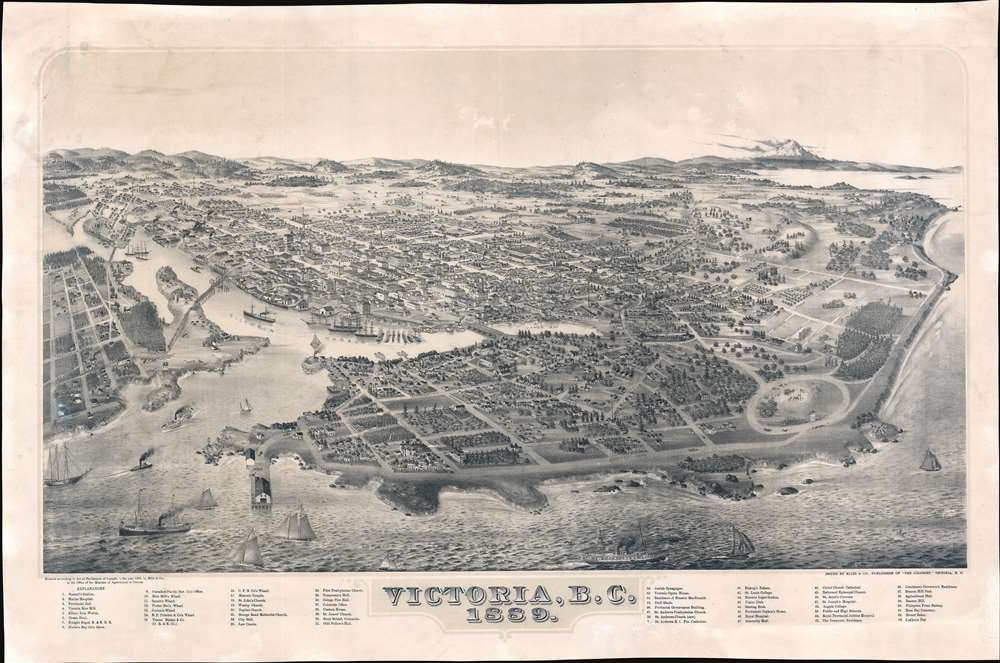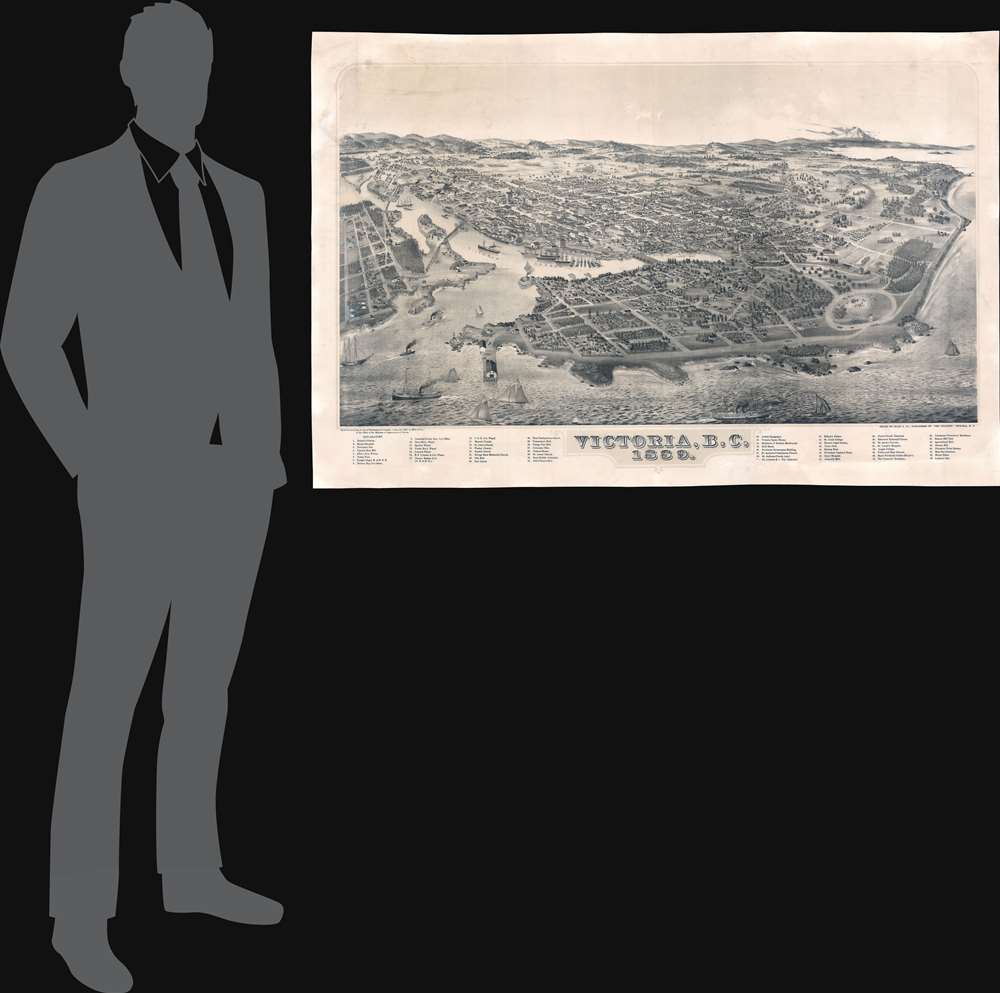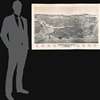This item has been sold, but you can get on the Waitlist to be notified if another example becomes available, or purchase a digital scan.
1889 Ellis Bird's-Eye View of Victoria, British Columbia
VictoriaBritishColumbia-ellis-1889
Title
1889 (dated) 28 x 42.25 in (71.12 x 107.315 cm)
Description
Real Estate in James Bay
The perspective focuses on the James Bay district, a peninsula to the south of the harbor - an area at the time lotted out but still largely undeveloped, as this image attests. We imagine that the viewmakers may have been encouraged to highlight this area by real-estate developers. By the 1890s, James Bay had developed into an elite enclave, the home of Cariboo Gold Rush millionaire William J. Pendray (1846 - 1913), lumber magnate William James Macaulay (1828 - 1902), and politician William John Macdonald (1832 - 1916) (Macdonald Park). Today, James Bay remains a popular, affluent community and the city's oldest neighborhood, known for its lively waterfront and charming Victorian houses.Notable Locations
Below the view, 63 key locations are noted. Among the most notable: (8) Hudson's Bay Co.; (9) Canadian Pacific Nav. Co's Office (the main passenger shipping line); (22) City Hall; (23) Law Courts; (27) The Colonist (Ellis and Co., where this view was printed); (32) Jewish Synagogue; (33) Victoria Opera House; (36) Provincial Government Building; (56) Lieutenant Governor's Residence; (57) Beacon Hill Park. Then, as now, Victoria Harbor, James Bay, and the Gorge Waters cut deep into the city. In the background, the stratovolcano Mount Baker (Kulshan) is recognizable in Washington state.The Mysterious R. H.
The artist is a mysteries 'R. H.', signed in the lower left corner. We do not know who R.H. might be. He also produced a view of Placerville, California for the Weekly Observer in 1888, Sacramento for the Daily Record-Union and Weekly Union c. 1900, and an 1890 View of Redding (Shasta), 1889, among others. He appears to have worked extensively for the Wallace William Elliott firm (fl. c. 1870 - c. 1890). Many of Elliott's viewmakers signed only by initials. Other initials on Elliott's more than 50 views include 'T.S.' and 'F.W.' View historian John William Reps speculates that these may be lithographers and that Elliott himself was the artist. The present view is the only known view signed by R. H. that was not published by Elliot. As viewmaking was a very specialized form of artistry, it is not surprising that Ellis would bring in a specialist from California to prepare his great view of Victoria, but it also suggests Reps may be incorrect, as someone had to have drawn this.Bird's-Eye City Views
The tradition of the bird's-eye city view emerged in the United States and Canada in the middle part of the 19th century and coincided with the commercial development of lithographic printing. While before the rise of lithography, the ability to own and display artwork in the home was largely limited to the extremely wealthy, lithographic printing made it possible for everyone to own visually striking artwork. A robust trade developed in portraits of political leaders, allegorical and religious images, and city views.Lithograph city views were being produced as early as the 1830s, but the genre exploded after the American Civil War (1861 - 1865). Bridging the gap between maps and pictures, most 19th-century American Bird's-eye views presented cities to the public high vantage points. Some were imagined, but others were drawn from hot-air balloons or nearby hills. The presentation, combining high elevation, commercial interest, and new printing technology, created a uniquely American art form, as described by historian Donald Karshan,
Some print connoisseurs believe that it was only with the advent of the full-blown city-view lithograph that American printmaking reached its first plateau of originality, making a historical contribution to the graphic arts. They cite the differences between the European city-view prints and the expansive American version that reflects a new land and a new attitude toward the land.The vogue for bird's-eye city views lasted from about 1845 to 1920, during which period some 2,400 cities were thus portrayed, some multiple times. Although views were produced in many urban centers, the nexus of view production in the United States was Milwaukee, Wisconsin. The major viewmakers were Stoner, Wellge, Bailey, Fowler, Hill, Ruger, Koch, Burleigh, Norris, and Morse, among others.
Chromolithography
Chromolithography is a color lithographic technique developed in the mid-19th century. The process involved using multiple lithographic stones, one for each color, to yield a rich composite effect. Oftentimes, the process would start with a black basecoat upon which subsequent colors were layered. Some chromolithographs used 30 or more separate lithographic stones to achieve the desired product. Chromolithograph color could also be effectively blended for even more dramatic results. The process became extremely popular in the late 19th and early 20th centuries when it emerged as the dominant method of color printing. The vivid color chromolithography produced made it exceptionally effective for advertising and propaganda imagery.Publication History and Census
The view was drawn by R.H., an unknown California artist, and published in Victoria by William H. Ellis in 1889. It is rare. Reps notes 8 known examples, 4 in Canada, 4 in the United States.Cartographer
William Harrington Ellis (October 31, 1859 - February 28, 1921) was a Canadian businessman and newspaper publisher based in Victoria, British Columbia. He was born in Port Hope, Ontario, where he grew up and apprenticed as a printer. He lived briefly in Winnipeg before settling in Victoria, British Columbia, in 1884. He immediately took a position with the local newspaper, The Colonist. Around 1886, Ellis partnered with Albert George Sargison (1862 - 1929) and W. R. Higgins to purchase The Colonist from the estate of David William Higgins (1834 - 1886). The colonist operated under the umbrella of Ellis and Co., which also published broadsides, books, guides, and views. In 1892, The Colonist was sold to James Dunsmuir (1851 - 1920). Ellis went on to invest heavily in real estate. He was married to Ada Leslie Withrow. More by this mapmaker...




